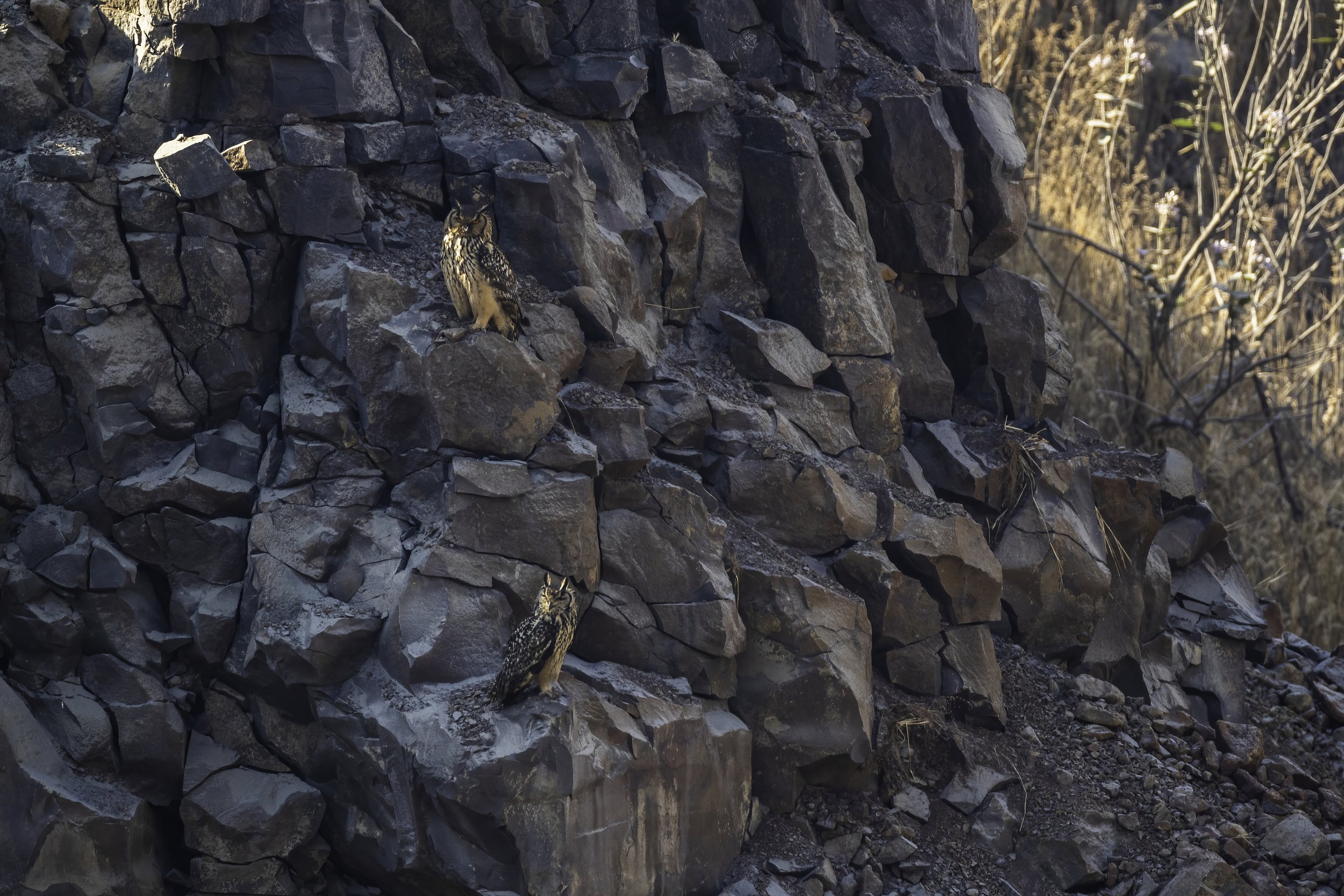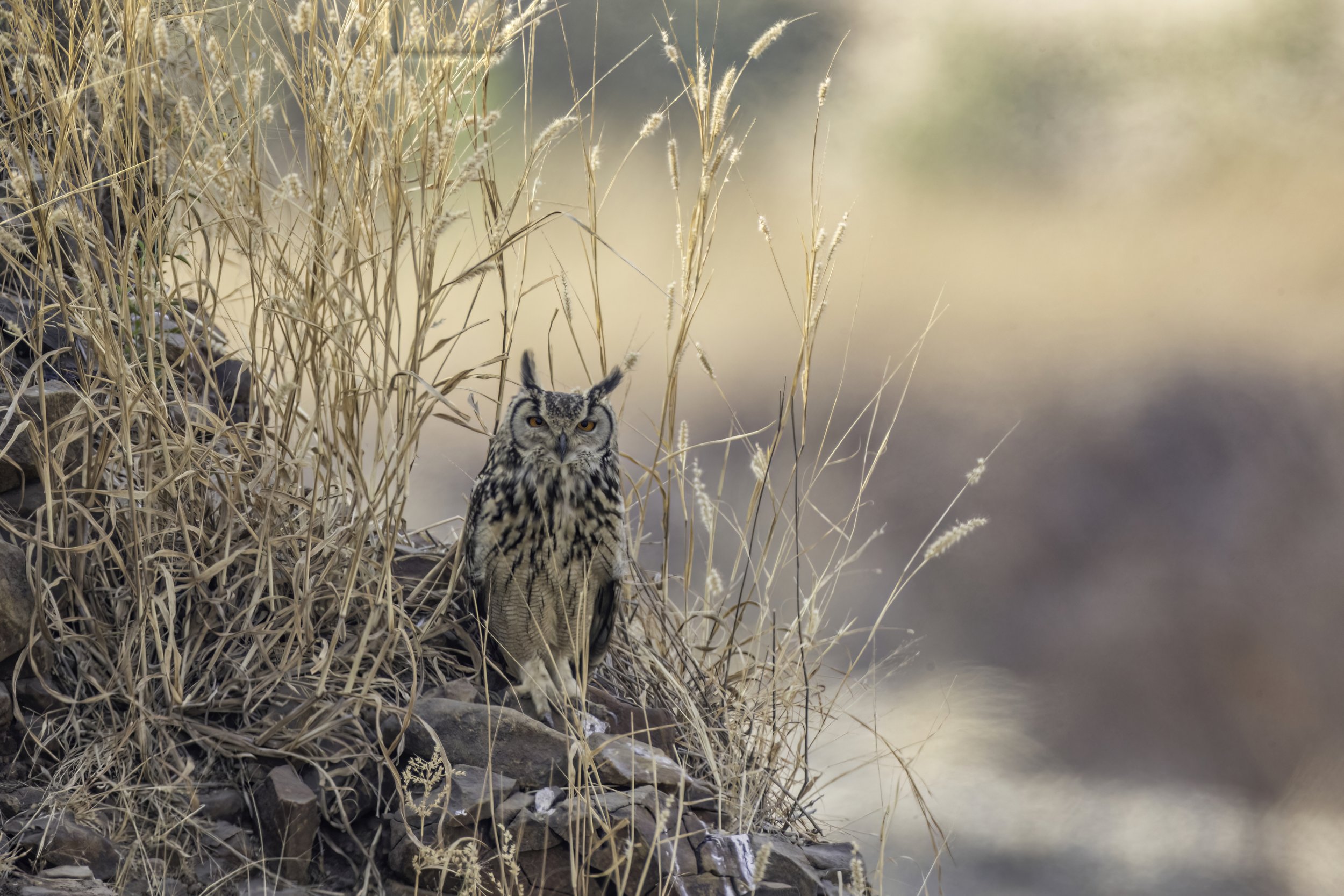Indian Eagle Owl/ Bengal Eagle Owl
Bubo bengalensis
Yenkathala/ Ramnathgudpalle Grasslands, Telangana
The Yenkathala/ Ramnathgudpalle grasslands are home to as many as 191 bird species and numerous wildlife species like the Indian Grey Mongoose. In winter these spectacular grasslands host some beautiful migrant harriers which migrate from Russia and Eastern Asian countries traveling over 5,000 kilometers to winter here in the dry sub-humid type of grasslands which cover almost the entirety of peninsular India except the Nilgiris. These grasslands are also home to a number of Indian/ Bengal Foxes - the smallest wild canid in India. The Indian or Bengal fox is found across large parts of western, central and peninsular India and can be distinguished from the morphologically similar desert fox based on its black tail-tip. These Indian foxes live in grasslands and agricultural fields, with a diet consisting of rodents and birds.
The dry deciduous forests ecoregion of the central Deccan Plateau covers much of the state, including Hyderabad. The characteristic vegetation is woodlands of Hardwickia binata and Albizia amara. Over 80% of the original forest cover has been cleared for agriculture, timber harvesting, or cattle grazing, but large blocks of forest can be found in the Nagarjuna Sagar - Srisailam Tiger Reserve and elsewhere. The more humid Eastern Highlands moist deciduous forests cover the Eastern Ghats in the eastern part of the state. The Central Deccan forests have an upper canopy at 15–25 meters, and an understory at 10–15 meters, with little undergrowth.
Grasslands are natural carbon sinks and therefore crucial to the global carbon cycle due to their high rates of productivity, enhanced carbon sequestration rates & geographical extent keeping global temperatures more or less in balance. They are also breeding grounds for many migratory and endangered species like the Indian Grey Wolf of which only about 3,000 are left in the wild. It is a common response from people to think forests when green cover is mentioned but grasslands are of equal import. These open natural ecosystems urgently need attention and government initiatives for protection and conservation. In Telangana, grasslands are located in the districts of Vikarabad, Nizamabad, Khammam, Siddipet and Nalgonda. The wildlife in these fragile ecosystems today face numerous threats like hunting, spread of the canine distemper virus which affects foxes, wolves & several other species, rabies from feral dogs and most crucially, habitat loss.
Read more about the wildlife of these magnificent and fast disappearing grasslands.
Over a number of weekends I had already spent a fair bit of time on these grasslands just sitting and watching and gradually the wildlife opened up showing me where they frequented. I had the good fortune to observe the harriers from close proximity (Video) without any disturbances and during these sessions I often noticed the owls - both the Indian Eagle Owl and the Short-eared Owl making their way back and forth from a point on the grasslands.
Indian/ Bengal Eagle Owl
The Indian/Bengal Eagle Owl was classified as a species only in recent years, thus distinguishing it from the Eurasian Eagle Owl. The Indian species is an imposing bird.
The Indian/ Bengal eagle-owl (Bubo bengalensis), also widely known as the Rock Eagle Owl, is a large horned owl species native to hilly and rocky scrub forests in the Indian Subcontinent. It is splashed with brown and grey, and has a white throat patch with black small stripes. It is usually seen in pairs. It has a deep resonant booming call that may be heard at dawn and dusk. The slightly larger female can reach a total length of two and a half feet, with a wingspan of six feet. Prominent ear tufts that look like horns project from its head. One theory holds that these have evolved to impart a threatening look that keeps away predators. If so, the horns are indeed successful at imparting an aura of menace.
Its nocturnal habits have meant that very little is known about this bird. The widespread range — the entire Indian peninsula — would seem to indicate that it is a stable population. But nobody knows for sure, as it is not a very common bird. Their total numbers have never been estimated. Many bird species face decline today as the total forested area in our country has suffered a decline. But the Indian Eagle Owl does not have a dependency on forests. The regular items on their menu, such as rats, bandicoots, and even bats and doves are best hunted over open scrubland and agricultural tracts. Nearby rocky perches and crags provide ideal settings for its nests. And this fact made the Yenkathala/ Ramnathgudpalle grasslands almost the perfect habitat for these owls as there is a substantial rock quarry here as well.
This species was often considered a subspecies of the Eurasian Eagle Owl (Bubo bubo) and is very similar in appearance. The facial disk is unmarked and has a black border, a feature that is much weaker in the Eurasian form. The base of the primaries is unbanded and rufous. The tail bands have the tawny bands wider than the black ones. A large pale scapular patch is visible on the folded wing. The inner claws are the longest. The last joint of the toes are unfeathered.
The taxonomy of the group is complex due to a large amount of variation. Dementiev was the first to consider the possibility of Bubo bengalensis being distinct within the Bubo bubo group. However, Charles Vaurie noted that this species as well as Bubo ascalaphus appeared to be distinct and not part of a clinal variation. There is a lot of colour variation with the ground colour being dark brown above while some are pale and yellowish. On dark birds the streaks coalesce on the hind crown and nape but are narrow in pale birds. However, Vaurie notes that despite the variation, they are distinct from neighbouring forms Bubo bubo tibetanus, Bubo bubo hemachalana and Bubo bubo nikolskii, in being smaller and richly coloured. Stuart Baker noted that there were two plumage variants that were seen across their range, one plumage has the back and scapulars spotted in white while the other form has a reduced number of white spots on the feathers of the back and the dark streaking on the back, neck and scapulars being prominent.
Chicks are born with white fluff which is gradually replaced by speckled feathers during the prejuvenile moult after about two weeks. After a month or so they go through a prebasic moult and a brownish juvenile plumage is assumed with the upperparts somewhat similar to adults but the underside is downy. The full adult plumage is assumed much later.
Indian Eagle Owl - Range & Distribution
They are seen in scrub and light to medium forests but are especially seen near rocky places within the mainland of the Indian Subcontinent south of the Himalayas and below 1,500 m (4,900 ft) elevation. Humid evergreen forest and extremely arid areas are avoided. Bush-covered rocky hillocks and ravines, and steep banks of rivers and streams are favourite haunts. It spends the day under the shelter of a bush or rocky projection, or in a large mango or similar thickly foliaged tree near villages. You can see this habitat at the beginning of my video.
Their deep resonant two-note calls are characteristic and males deliver these "long calls" mainly at dusk during the breeding season. The peak calling intensity is noticed in February. Young birds produce clicks, hisses and open up their wings to appear larger than they are. Nesting adults will fly in zig-zag patterns and mob any potential predators (including humans) who approach the nest.
Its diet through much of the year consists of rodents, but birds seem to be mainly taken towards winter. Prey species of birds include Francolins, Doves, Indian Roller, Shikra, Black Kites, House Crows and the Spotted Owlet. Birds the size of a Peafowl are sometimes attacked. Rodents noted in a study in Pondicherry were Tatera indica, Gollunda ellioti, Rattus specifically Mus booduga and Bandicota bengalensis. Indian Flying Fox are also preyed on. In Pakistan, Nesokia indica is an important prey item in their diet. Mammals the size of an Indian Hare (Lepus nigricollis) may be taken. These owls have also preyed on Lepus capensis and Eupetaurus cinereus.
When feeding on rodents, it tears up the prey rather than swallowing it whole.
The nesting season is November to April. The eggs number three or four and are creamy white, broad roundish ovals with a smooth texture. They are laid on bare soil in a natural recess in an earth bank, on the ledge of a cliff, or under the shelter of a bush on level ground. The nest site is reused each year. The eggs hatch after about 33 days and the chicks are dependent on their parents for nearly six months.
This large owl with its distinctive face, large forward-facing eyes, horns and deep resonant call is associated with a number of superstitions. Like many other large owls, these are considered birds of ill omen. Their deep haunting calls if delivered from atop a house are considered to forebode the death of an occupant. A number of rituals involving the capture and killing of these birds have been recorded. Salim Ali notes a wide range of superstitions related to them but notes two as being particularly widespread. One is that if the bird is starved for a few days and beaten, it would speak like a human, predicting the future of the tormentor or bringing them wealth while the other involves the killing of the bird to find a lucky bone that moved against the current like a snake when dropped into a stream.
Read about the other owls I have photographed.
‡‡‡‡‡
There are two Indian Eagle Owls in the following two pictures. One visible perched on the rocks and the other practically invisible hidden in the long grass to the above and left of the first. Do comment if you can spot the second owl. :)
Hint: in the second image it turned to look at the camera.
Related Posts






















